Knauf Fugen Universal Blend
Views:
- Hydro - used for filling moisture-resistant gypsum plasterboard. The putty contains hydrophobic impurities;
- GF - for ordinary plasterboard sheets;
- Fugen is simple.
The first two types are not found in every hardware store. It is better to look for them in Knauf specialized stores.
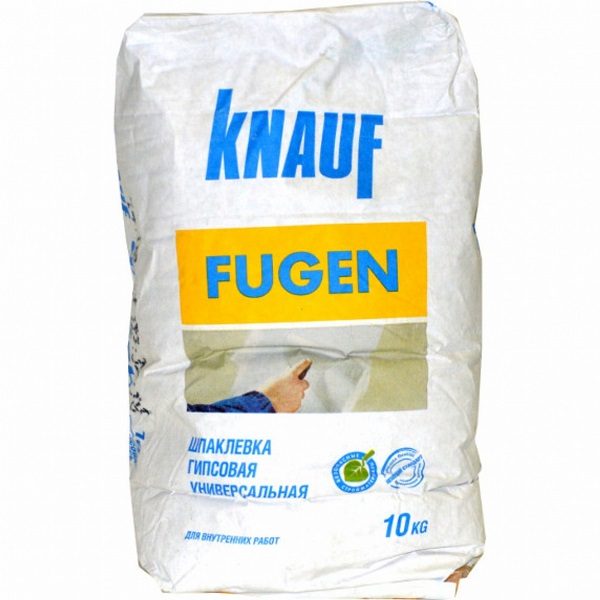 Putty mixture Knauf Fugen
Putty mixture Knauf Fugen
The putty got widespread due to the versatility of the composition. It is used for:
- Sealing joints between sheets of plasterboard using serpyanka;
- Repairing damage - irregularities, cracks, seams, etc .;
- Puttying with a thin layer of plastered and concrete bases;
- Filling joints when assembling tongue-and-groove slabs, concrete elements;
- Bonding to flat substrates of gypsum plasterboards - permissible surface difference is maximum 4 mm;
- Filling and gluing of gypsum elements;
- Fixing metal corners for protection.
Composition Knauf Fugen environmentally friendly material. Professional builders highlight the following advantages:
- Coating with impressive strength indicators;
- Low consumption;
- High quality base. It is suitable for wallpapering and applying paints and varnishes;
- Large selection of packaging;
- Affordable cost of the mixture.
The standard Knauf Fugen has the following characteristics:
- The thickness of the applied layer is 0.1 - 0.3 cm;
- Material consumption when applying a layer of 0.1 cm - 0.8 kg / m2;
- When sealing the seams, it is consumed - 0.25 kg / m;
- Flexural strength - 1500 kPa;
- Compressive strength - 3000 kPa.
However, despite the high performance and wide range, the use of Knauf Fugen also has disadvantages:
- The prepared mixture hardens rather quickly;
- Difficulties at the stage of grinding - great effort is applied, even when using an abrasive mesh No. 100 for surface treatment;
- It is impossible to finish with a layer exceeding 0.3 cm;
- When pasting the base with wallpaper of light shades, dark gaps may appear.
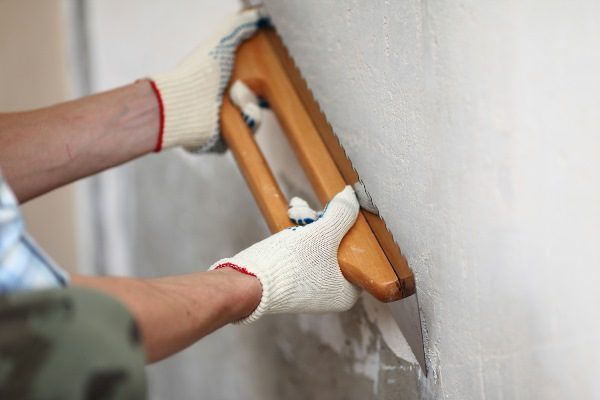 Puttying the base Knauf Fugen
Puttying the base Knauf Fugen
Recommendations for working with putty from Knauf Fugen
Gypsum putty has one property that affects the entire workflow - it dries quickly. Therefore, it is more economical to use dry mixtures, since undiluted powder can be stored for a long time.
The mixture is diluted in a small, clean container. The thicker the structure of the putty, the less likely it is to form lumps. But such a consistency is used for reapplication, and for the first layer a more liquid one is prepared, the lumps do not play a special role here, they level out when distributed over the surface.
For puttying, use narrow spatulas: 15-20, 20-25, 30-50 cm. Which one to choose, they are guided by the unevenness of the treated surface.
Finishing putty - consumption per 1 m2.
Finally, the finishing putty is placed on top of the starting plaster, in order to make the ceiling or wall perfectly flat and smooth. It is especially needed for such capricious finishes as subsequent painting. Finishing putties are produced in the form of dry mixes, as well as ready-made in special buckets weighing 25, 17 or 8 kg, although there are even smaller containers. For the final alignment, it is preferable to use the ready-made mass, although it will cost a little more. For example, you can recommend finishing putty "Shetrok USG", "Acryl Putz Finish" or acrylic mass "SATYN PG-007".
In addition to the ready-made mass, dry mixes like Vetonit LR + based on special polymer components are used for the final leveling of walls. It is sold in a 25-kg package. The consumption of the finishing "vetonite" is 1.2 kg per unit area in a layer of 1 mm.You can putty here thicker: the thickness of one laying of the mixture per pass is taken within 1-5 mm.
Or here's another alternative - Knauf Satengips finishing putty in a 25-kg package with the minimum possible layer of 0.2 mm, the maximum - 5 mm. Consumption: 1 kg of composition per "square" of the wall with a millimeter layer thickness.
As you can see, in different manufacturers, the consumption rates of the putty are different. In order not to be mistaken, especially with a shortage of building materials, take the initial parameters of the mixture consumption on the package, multiply them by the area of the wall to be treated and add 15% to the result. Accordingly, if a layer of putty is planned for more than 1 millimeter, multiply everything by the desired thickness coefficient and, as a result, get the required amount of material.
Application recommendations
Before applying the putty to the walls, it is necessary to acquire all the tools necessary for this process, indicated in the official instructions for the mixtures:
- container for the preparation of putty;
- metal spatula for mixing;
- mixer for plaster;
- standard metal spatula (15 cm);
- wide metal spatula (more than 20 cm);
- metal spatula for processing corners;
- abrasive mesh for sanding the dried surface after putty.
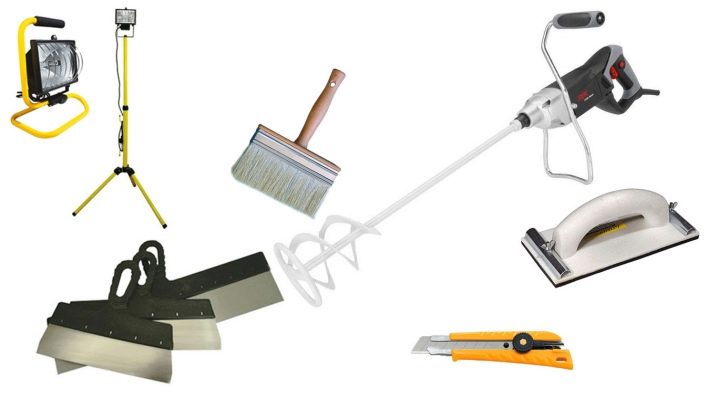
The container for mixing the mixture and all tools must be thoroughly washed and freed from residual traces of previous mixtures or use new ones. In a dirty container, fresh putty dries twice as fast, its service life is reduced to 15 minutes.
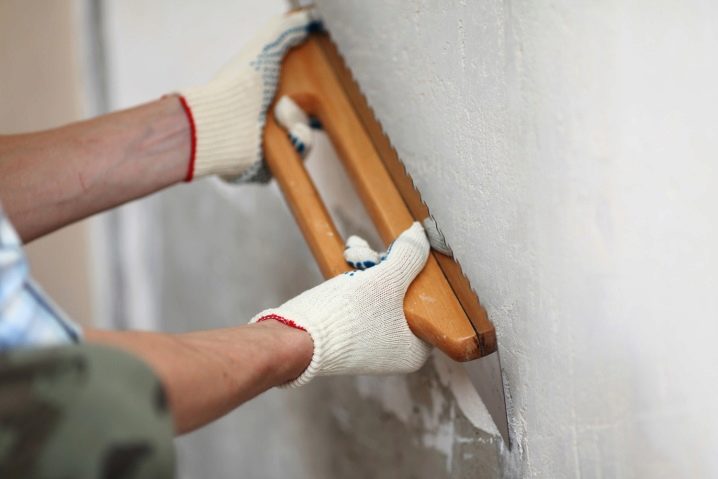
To mix a solution of the correct consistency, you should pay attention to the following points:
- Pour dry putty (1 kg) into water (0.8 l) slowly, spreading it throughout the volume. Handwork is especially important here.
- As soon as the level of dry putty slightly exceeds the level of water in the container, let the mixture brew. You can take no more than 2-3 minutes for this.
- Proceed with active kneading. In rare cases, you can use a construction mixer, but professionals insist on manual mixing of the mixture.
At first it may seem that the consistency is too liquid to be applied to the walls. However, after a couple of minutes, the density will noticeably increase, and the solution will become as it should.

It should be noted that for the initial application, a more liquid consistency of the putty is suitable, so that it is easier to apply a thin even layer of up to 3 mm. For further use and for patching up irregularities, cracks and other flaws, a mixture that is thicker in structure is suitable. Then the thickness of the layer will not matter so much.
You will learn more about the features of applying Knauf Fugen putty in the following video.
Features of drawing Knauf Rotband
Before using Rotband Paste putty, the treated smooth surface, if there are no visible defects on it, is cleaned of dust and dirt, treated with a primer, and the manufacturer recommends using Tiefengrud adhesive solution. The protruding metal parts are treated with anti-corrosion solutions. At the same time, the surface temperature does not exceed 5 degrees. In case of unevenness, a layer of plaster is used. The instructions for performing work include the following points:
- Installation on the surface of lighthouses using plumb lines or a building level;
- Application with an even layer of leveling plaster;
- After the mass has dried, cover it with a primer mixture;
- A putty is applied with a stainless steel spatula or a Swiss falcon, smoothed over the entire surface up to the base, stretched to the required layer thickness using the “scraper” method, in which the mixture is applied from a narrow spatula to a wide one and then transferred to the surface at an angle of 45 degrees;
- If necessary, apply another layer of putty;
- After the mass has dried, the surface is sanded, sanding is done wet and dry, using a sponge or wet sandpaper;
- During application and at the end of treatment, the tool used is rinsed under running water.
Peculiarities
Knauf Fugen gypsum universal putty used to have a longer name - Fugenfuller. This is a classic gypsum-based putty, which has firmly established itself in the world market of dry building mixtures.
The main feature of this material is the guarantee of success at any labor costs, provided that the instructions are followed unconditionally:
- Observe the room temperature and air humidity. So, in the room where the surfaces will be treated with Knauf Fugen putty, there should be no more than +10 degrees Celsius. And the humidity should not exceed the standard values of 70-80%.
- Pre-treat surfaces with a primer, clean and dry.
- Tools for work must always be clean, otherwise the mixture risks acquiring a heterogeneous structure and, as a result, will not meet your requirements.
The gypsum base of the mixture does not allow a large amount of putty to be used for a long time. It dries very quickly, therefore it is recommended to dilute the mixture in small quantities.
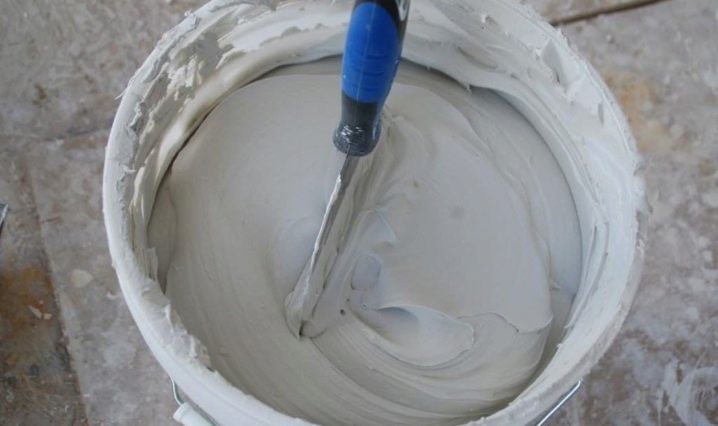
Due to its crushed structure, Fugen can be used as a finishing layer before applying paint, wallpapering, etc. Of course, one layer is not enough, because, like any other gypsum putty, it will shrink.
Many users note the difficulties they face in the process of processing Knauf Fugen surfaces. It is advised to resort to less capricious counterparts, which are inferior to the German manufacturer not only in price, but also in quality. And, therefore, in the end result.
In general, Knauf Fugen putties have positive reviews, but sometimes not the most pleasant words about a professional product happen.
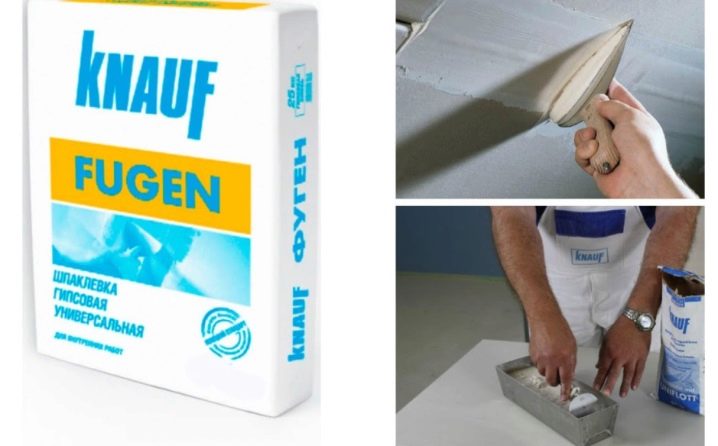
Rules for working with the material
To obtain high-quality results of work, it is necessary to follow some of the recommendations of specialists:
- It is recommended to putty at a room temperature of at least + 10 ° C and a humidity of not more than 80%.
- Before applying raw materials, it is necessary to carry out preliminary cleaning and priming of the surface. Putty can only be applied on a dry surface.
- It is only necessary to prepare the solution in a clean container. If foreign matter gets in, rinse the instruments and remove foreign matter from the composition.
- During the preparation of the solution, it is not recommended to take more than 1 kg of the substance. With a lack of experience, you may not have time to use up the entire mixture, which cannot be reused.
- To prepare the solution, take only clean water and pour the purchased composition into it. Stir begins after all the powder is wet. After the first mixing, wait for a while and mix a second time. To avoid the formation of lumps and to facilitate the mixing process, you can use a construction mixer. The finished solution should have the consistency of thick sour cream.
- To exclude rapid hardening and the formation of a large number of lumps, a new portion of the solution is kneaded in a previously washed container. The tool should also be washed after finishing the application of the mixture.
- To work with joints, use a serpyanka mesh or a special paper tape. They increase the strength of the seams, but still do not guarantee the absence of cracking.
- When sealing joints and seams, the second layer is applied only after the first layer has completely dried.
The remains of the finished material after work must be disposed of. When adding residues to a new composition, a large number of lumps can be obtained. They should not be flushed down the drain due to the potential for persistent blockages. Leftover dry material should be stored in a tightly closed plastic bag. It is not recommended to use raw materials after the expiration date.
Choosing a quality manufacturer of finishing materials avoids frequent renovation of premises. Many professionals give preference to finishing raw materials, including putty, Fugenfüller Knauf, which has long been successfully used in interior renovation. These materials have long established themselves as high quality and durable.
Scope of use
The putty composition can be used for various purposes without the risk of loss of properties:
- filling seam joints of concrete floors;
- plasterboard finishing (the solution is laid at the butt areas);
- restoration of plasterboard, concrete, tongue-and-groove slabs;
- plastering the entire surface of the structure (partitions, walls);
- reinforcement (putty is used to fasten the mesh, reinforcing corners);
- fixing plasterboard sheets on a pre-leveled vertical surface;
- create a rough base over sheets of drywall for wallpapering;
- filling in the recesses at the points of installation of the fasteners (hide the caps).
Preparation of putty Knauf Uniflot
Preparation is important, because due to the use of the mixture not according to the rules, deterioration occurs, and technical characteristics are reduced. We process the surface, without fail, clean it from dust and dry it. Pre-priming will not be superfluous. Before carrying out work, the surface must be thoroughly cleaned, otherwise there is a possibility of deterioration in the quality of adhesion of the putty to the sheet. The characteristics of the place of application are strength and hardness. This guarantees quality.
Particular attention is paid to the correct preparation of the solution. 1 liter of water is used per 2 kg of dry mixture, mixed until a homogeneous mass is created
It is not recommended to exceed the amount of putty for this volume of liquid, if the mixture is too fluid, then it will flow down the wall.
There are 50 minutes to apply the resulting mixture, since after this time the material will set and it will harden in the vessel. It will be impossible to use it.
Commercially available varieties
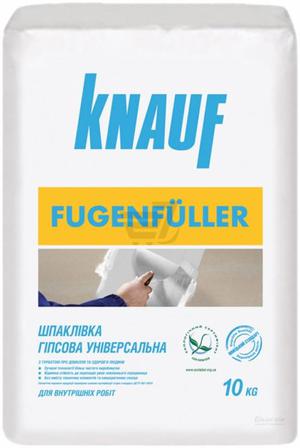 Depending on the place where the material is applied, a suitable type of putty should be selected. The manufacturer offers putty for gypsum fiber sheets - Knauf Fugen G.V. and material for work in places with high humidity - Fugen Hydro.
Depending on the place where the material is applied, a suitable type of putty should be selected. The manufacturer offers putty for gypsum fiber sheets - Knauf Fugen G.V. and material for work in places with high humidity - Fugen Hydro.
The first option is intended for sealing seams and minor irregularities. In terms of its composition, this mixture has almost the same composition as the universal remedy. The differences lie in the permissible thickness of the applied layer and the consumption of the prepared substance.
To cover seams and joints, it takes up to 600 grams of the mixture. With a continuous application of raw materials with a thickness of 1 millimeter, it will take up to 1.2 kilograms. The rest of the material has similar characteristics with the universal mixture.
The second material contains special additives that make it possible to use it:
- For the purpose of gluing moisture-resistant drywall to a flat surface, as well as filling and gluing gypsum raw materials.
- For filling joints between drywall sheets in damp rooms.
- As an element for filling cracks or depressions in concrete floors.
- For filling and installation of tongue-and-groove moisture-resistant boards.
The rest of the characteristics are no different from the universal composition of the fugenfüller putty. The maximum applied layer thickness should not exceed 5 mm. A moisture-resistant analogue will cost twice as much as universal products.
Features of the work
Apply Sheetrock plaster on a stable, hard, clean and dry substrate. Remove all substances that have a negative effect on adhesion. These are resin, chalk, dust, paints and varnishes, etc. Hygroscopic bases are pre-primed.
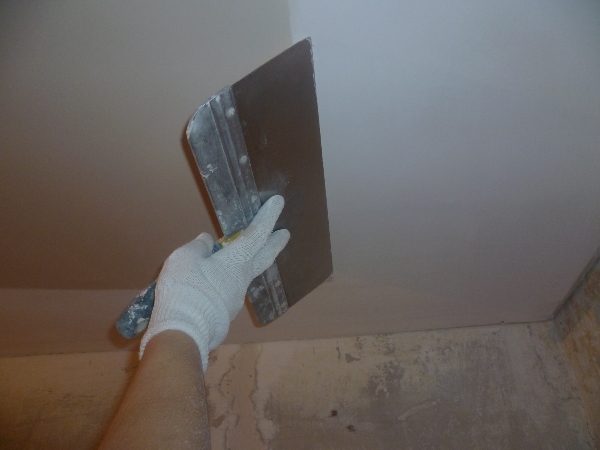 Perfect surface with Sheetrock
Perfect surface with Sheetrock
The putty mixture is applied mechanically or manually. Each next layer is applied after the previous layer has completely solidified.This requires at least 3 hours, preferably 5. After the final hardening, sand the surface. This will require abrasive paper, the size of which does not exceed 240 units.
Consumption of knauf fugenfüller putty per 1m2
As for the consumption when using the material, its rates vary greatly, for example:
- To eliminate the joints of gypsum plasterboard joints, the knauf mixture is spent at the rate of 0.25 kg per 1m2;
- With continuous puttying with a layer thickness of 1 millimeter, the consumption will be 0.8 kg per square meter;
- When installing the slabs, the consumption of the fugenfüller starting solution is approximately 1.5 kg per meter.
Storage
It is recommended to store knauf fugenfüller paper bags in dry and well-ventilated rooms, on shelves or stands, never leave them on the floor. If suddenly the packaging was damaged during transportation, then first of all use this particular material.
The storage time in a whole package is half a year, then the mixture can be compressed and absorb moisture, stone formations appear that are not suitable for plastering.
How to prepare the surface for Knauf Fugenfjuller to work?
The requirements for working with Knauf mixtures are the same as for other manufacturers. The main thing is that the base on which the putty will be applied is dry and has a temperature of about + 15 ° C.
Do not forget to also pre-clean the surface and dust and dirt, pre-walk with a brush to remove old topcoats.
If your jobsite is good at absorbing moisture, first primer with a roller or brush with a native Knauf primer (K 455) before starting work.
Remember that smooth surfaces with moisture repellency should be treated with concrete to increase the contact area.
How to prepare the solution correctly?
It is quite simple to prepare a fugenfüller plaster mixture, just take a dry container and fill it with the required amount of starting material; observe the proportions of 2.5 kg of powder per 2 liters of cold water.
Now let stand and soak for about 2 minutes, then mix everything thoroughly with a spatula or stir everything with a construction mixer. A homogeneous creamy gruel is considered ideal, to which nothing else is added!
If it suddenly happens that the mixture has frozen, you will not help it, the additional amount of water and stirring will not be able to "revive" it.
Remember! That you have about 30 minutes before the solution starts to harden.
Conditions for working with plaster solutions
The main requirement for working with a fugenfüller solution is compliance with the temperature regime, the room in which finishing manipulations are performed must be heated to 10-15 degrees Celsius.
How to correctly seal the joints of the gypsum board
To achieve a perfectly flat surface between two drywall sheets, it is enough to follow the instructions:
- Apply a little putty mixture to the places of their connection;
- Lay the reinforcing tape evenly (pre-adjusted to size) and press it gently with a spatula, avoiding the formation of irregularities;
- The second coat can now be applied to the hardened surface;
- The final step is to remove excess and irregularities using a grinding wheel on a grinder (or manually with sandpaper), after eliminating the shortcomings, a finishing layer is applied at the discretion.
